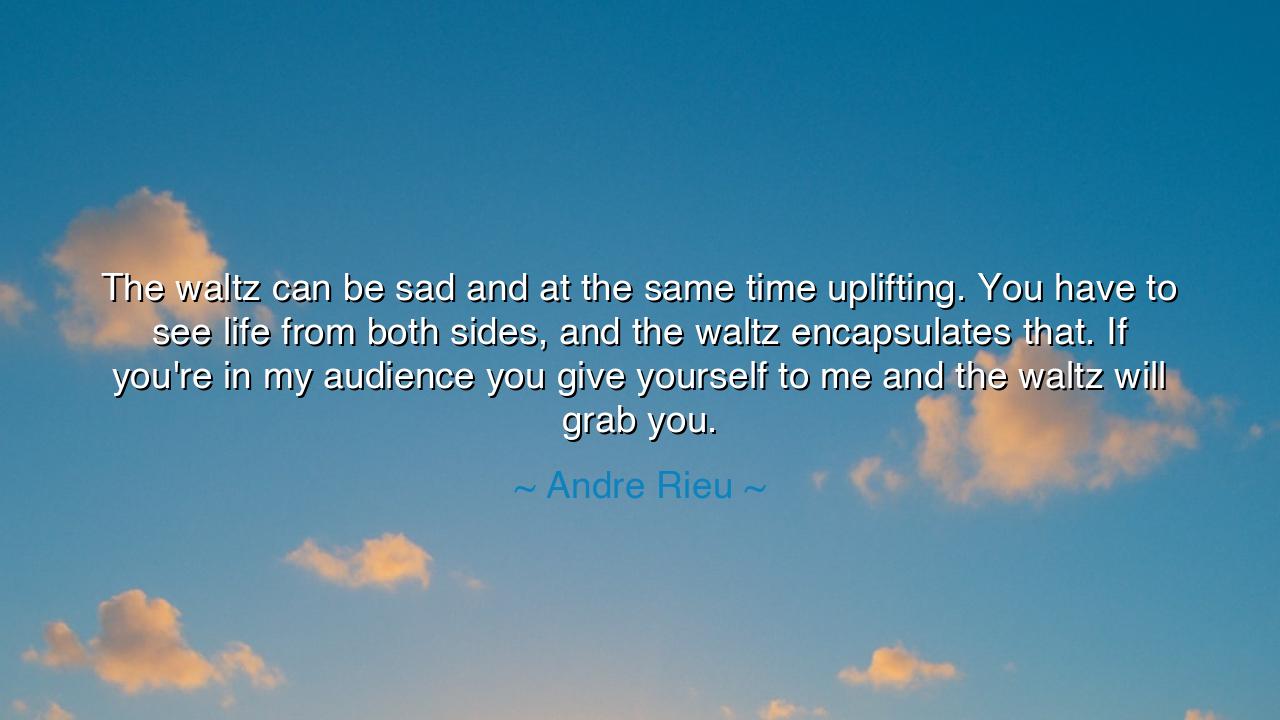
The waltz can be sad and at the same time uplifting. You have to
The waltz can be sad and at the same time uplifting. You have to see life from both sides, and the waltz encapsulates that. If you're in my audience you give yourself to me and the waltz will grab you.






There are melodies that do not simply move the feet—they move the soul. André Rieu, master of the waltz, once said, “The waltz can be sad and at the same time uplifting. You have to see life from both sides, and the waltz encapsulates that. If you're in my audience you give yourself to me and the waltz will grab you.” These are not the words of a mere musician, but of a philosopher of rhythm. For in the elegant swirl of the waltz, he sees the mirror of life itself—its joy and sorrow intertwined, its laughter trembling on the edge of tears. The waltz, he tells us, is not just a dance; it is a metaphor for existence, teaching that beauty often lives within contradiction.
In its origins, the waltz was born from the folk dances of the Austrian countryside, rising in the late eighteenth century to captivate the salons of Vienna. It was both scandalous and divine—the first dance where partners embraced, turning in intimate circles that mirrored the cycles of the moon, of seasons, of time itself. To those who watched, it seemed a symbol of life’s daring intimacy: how two souls might spin together through both sorrow and delight, always on the edge of imbalance, yet always finding rhythm. It is this eternal balance of grace and gravity, of joy touched by sadness, that Rieu calls the true spirit of the waltz.
When Rieu says the waltz can be sad and uplifting, he touches upon one of the oldest truths of art: that the most profound beauty lies in duality. The ancient poets knew it well—Orpheus, whose song could charm the underworld, wept even as he played; Beethoven, whom Rieu reveres, wrote symphonies of triumph that rose out of despair. The waltz embodies this same paradox. Its rhythm is tender but unrelenting, its melody sweet yet tinged with melancholy. It reminds us that joy does not exist without pain, and that sorrow, when held with dignity, can become music.
To “see life from both sides,” as Rieu urges, is to live with eyes open to all that is. Most people wish only to dance in happiness, to spin in the light—but the wise understand that every waltz must also pass through shadow. The slow step of loss, the turn of forgiveness, the gentle lift of hope—these are the movements that give life its rhythm. The waltz teaches that we must not fear the sadness in joy, nor reject the joy in sadness. To live fully is to embrace both, to move with the music even when it changes key.
Rieu speaks also of connection, that sacred bond between performer and listener, between soul and sound. “If you’re in my audience, you give yourself to me and the waltz will grab you.” This is no command—it is an invitation. He asks his listeners to surrender, to trust, to let go of control long enough to feel something real. For in that moment of surrender, something miraculous happens: the individual dissolves into the collective rhythm, and the heart learns what words can never say. The waltz, like love itself, can only be known through participation. You cannot watch it—you must enter it.
Consider the story of Johann Strauss II, the “Waltz King” of Vienna, whose music once united a divided Europe. His most famous piece, The Blue Danube, was written in a time of national despair, after Austria’s defeat in war. Yet when he conducted it before his people, the hall transformed: the sadness of loss turned to pride, the heaviness of grief lifted into grace. In that moment, the waltz became not mere entertainment but resurrection. This is what Rieu means when he says the waltz “will grab you”—it seizes the heart and carries it beyond itself, turning sorrow into motion, despair into dance.
And so, the lesson of Rieu’s words is one of wholeness. Life, like the waltz, is not meant to be perfect; it is meant to be felt. When sadness comes, do not flee from it; when joy arrives, do not cling too tightly. Let both flow through you as the rhythm flows through the dancer. To resist the music is to stumble; to move with it is to find grace. The waltz teaches balance—not the still balance of stone, but the living balance of motion, the harmony of opposites joined in eternal turning.
Therefore, walk through life as though you are always in a waltz—with the courage to face sadness and the openness to feel joy. Give yourself to each moment, as Rieu asks his audience to give themselves to the music. For only when you surrender to life’s rhythm will you find the beauty that lies between laughter and tears, between rise and fall, between step and spin. In that sacred dance, sorrow becomes sweet, joy becomes deep, and the heart learns the oldest truth of all—that even in sadness, there is something uplifting, something divine, calling us always to keep on dancing.






AAdministratorAdministrator
Welcome, honored guests. Please leave a comment, we will respond soon